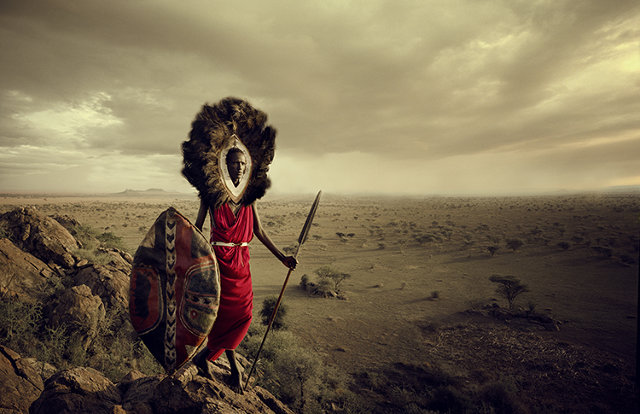Should Beauty Trump Authenticity?
 Stunning photographs of disappearing tribes from Jimmy Nelson's new book, Before They Pass Away, have been circulating recently online. Undoubtedly beautiful images, the work has been praised as, "epic portraits that present these dignified inheritors of noble and age-old traditions in a proud spirit and in all their glory—a unique visual experience."Critics offer another point of view as posted in the comments section on Fast Company's website:
Stunning photographs of disappearing tribes from Jimmy Nelson's new book, Before They Pass Away, have been circulating recently online. Undoubtedly beautiful images, the work has been praised as, "epic portraits that present these dignified inheritors of noble and age-old traditions in a proud spirit and in all their glory—a unique visual experience."Critics offer another point of view as posted in the comments section on Fast Company's website:
This is disturbing. It has popped up a number of times on my newsfeed. It is yet another white westerner's fascination with the authentic and exotic 'other'. This book is totally reminiscent of nineteenth century Social Darwinism and the euro centric belief that 'primitive' cultures were destined to die out when confronted with European 'civilisation'.
I thought what an amazing project then I saw his work on Maori in New Zealand. That is bullshit. No Maori dress like that now and haven't for at least 100 years or more. This is total fabrication. Such a disappointment.
I also wonder about the ethics of such a project since Nelson admits that he couldn't communicate verbally with most of his subjects? Nelson also said "They risk abandoning their authenticity and go towards the material world.” I wonder how much money he will make from his own little piece of material culture.
Nelson says, "I didn't start this project anticipating that I could stop the world from changing. I purely wanted to create a visual document that reminds us and generations to come of how beautiful the human world once was."The controversy surrounding Nelson's work is not new; the beauty of these images brings to mind the work of Edward Curtis. During the early part of the 1900s Curtis undertook a project of photographing Native Americans that would span thirty years, and stir up issues of authenticity and ethics along the way. Creating what many felt were overly romanticized images, Curtis was accused of image manipulation when it was discovered that he had retouched images to remove elements of civilization—as he did in one image that proudly displayed an alarm clock. Some also felt it was not authentic documentation since he posed his subjects and asked them to don ceremonial headdresses and leggings. Curtis felt his portraits gave face to the indigenous peoples of North America, who were threatened by extinction.This question isn't unique to disappearing human cultures; the adoption of the polar bear as a mascot in the fight against global warming raises the same types of questions. Portrayed in Coca-cola ads as pure and adorable creatures, real polar bears have been documented eating their own cubs. One can understand how the cute and adorable polar bear image would engage more supporters than a blood-thirsty cannibal.At the heart of this debates lies the never-ending question that photographers and graphic designers alike wrestle with: what's more important—authenticity—or creating awareness, empathy, and support?Sources:http://www.fastcoexist.com/3021773/see-these-heartbreaking-photos-of-worlds-disappearing-cultures-before-they-fade-awayhttp://www.huffingtonpost.co.uk/2013/11/04/lost-tribes-before-they-pass-away-jimmy-nelson-_n_4212518.htmlhttp://www.nytimes.com/2012/11/12/books/short-nights-of-the-shadow-catcher-by-timothy-egan.htmlhttp://www.loc.gov/pictures/collection/ecur/item/96515425/resource/http://www.coca-colacompany.com/stories/coke-lore-polar-bearshttp://www.dailymail.co.uk/sciencetech/article-2071638/Polar-bears-Cannibal-pictures-prove-theyll-eat-bear-cubs.html
Creating what many felt were overly romanticized images, Curtis was accused of image manipulation when it was discovered that he had retouched images to remove elements of civilization—as he did in one image that proudly displayed an alarm clock. Some also felt it was not authentic documentation since he posed his subjects and asked them to don ceremonial headdresses and leggings. Curtis felt his portraits gave face to the indigenous peoples of North America, who were threatened by extinction.This question isn't unique to disappearing human cultures; the adoption of the polar bear as a mascot in the fight against global warming raises the same types of questions. Portrayed in Coca-cola ads as pure and adorable creatures, real polar bears have been documented eating their own cubs. One can understand how the cute and adorable polar bear image would engage more supporters than a blood-thirsty cannibal.At the heart of this debates lies the never-ending question that photographers and graphic designers alike wrestle with: what's more important—authenticity—or creating awareness, empathy, and support?Sources:http://www.fastcoexist.com/3021773/see-these-heartbreaking-photos-of-worlds-disappearing-cultures-before-they-fade-awayhttp://www.huffingtonpost.co.uk/2013/11/04/lost-tribes-before-they-pass-away-jimmy-nelson-_n_4212518.htmlhttp://www.nytimes.com/2012/11/12/books/short-nights-of-the-shadow-catcher-by-timothy-egan.htmlhttp://www.loc.gov/pictures/collection/ecur/item/96515425/resource/http://www.coca-colacompany.com/stories/coke-lore-polar-bearshttp://www.dailymail.co.uk/sciencetech/article-2071638/Polar-bears-Cannibal-pictures-prove-theyll-eat-bear-cubs.html